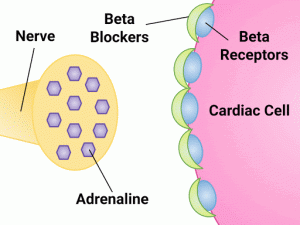1.7 Pharmacodynamics
Complex Interactions
So far, we have learned the importance of pharmacokinetics in describing how the body absorbs, moves, processes, and eliminates a medication. Now let’s consider a drug’s impact on the body, a series of complex interactions known as pharmacodynamics.
When considering how the cells of the body respond to medications, it is important to remember that the majority of drugs bind to specific receptors on the surface or interior of cells. However, there are many other cellular components and non-specific sites that can serve as receptor sites where drugs can bind to create a response. For example, did you know that an osmotic laxative like magnesium citrate attracts and binds with water? This medication works to pull water content into the bowel and increases the likelihood of a bowel movement.
Other medications may inhibit specific enzyme binding sites in order to impact the functionality of a cell or tissue. For example, antimicrobial and antineoplastic drugs commonly work by inhibiting enzymes that are critical to the function of the cell. With blockage of the enzyme binding site, the cell microbe or neoplastic cell is no longer viable and cell death occurs.
Agonist and Antagonist Actions

Understanding the mechanism of action,[1] or how a medication functions within the body, is essential to understanding the processes medications go through to produce the desired effect (see Figure 1.7). Drugs have agonistic or antagonistic effects. A drug agonist binds tightly to a receptor to produce a desired effect. A drug antagonist competes with other molecules and blocks a specific action or response at a receptor site. For example, the cardiac medication atenolol is a beta-1 receptor antagonist used to treat clients with hypertension or heart disease. Beta-1 receptor antagonist medications like atenolol produce several effects by blocking beta-1 receptors: a negative inotropic effect occurs by weakening the contraction of the heart, thus causing less work of the heart muscle; a negative chronotropic effect occurs when the heart rate is decreased, and a negative dromotropic effect occurs when the conduction of the electrical charge in the heart is slowed. Understanding the effects of a beta-1 antagonist medication allows the nurse to anticipate the expected actions of the medication and the client’s response. Agonistic and antagonistic effects on receptors are further discussed in the “Autonomic Nervous System” chapter.
Clinical Reasoning and Decision-Making 1.7
![]() Atenolol (Tenormin) is a beta-1 antagonist with negative inotropic and chronotropic effects. What should a nurse assess before administration?
Atenolol (Tenormin) is a beta-1 antagonist with negative inotropic and chronotropic effects. What should a nurse assess before administration?
Note: Answers to theses activities can be found in the “Answer Key” sections at the end of the book.
Attributions
- “Agonist and Antagonist Actions” was adapted from Principles of Pharmacology by Carl Rosow, David Standaert, & Gary Strichartz (republished by LibreTexts), which is licensed under CC BY-NC-SA 4.0 licence.
- "Mechanism of Action" by Dominic Slausen at Chippewa Valley Technical College is licensed under CC BY 4.0 ↵
The study of how drugs act at target sites of action in the body.
How a medication works at a cellular level within the body.
A drug which binds to its "receptor" and produces its characteristic effect.
A molecule that prevents the action of other molecules, often by competing for a cellular receptor; opposite of agonist.

